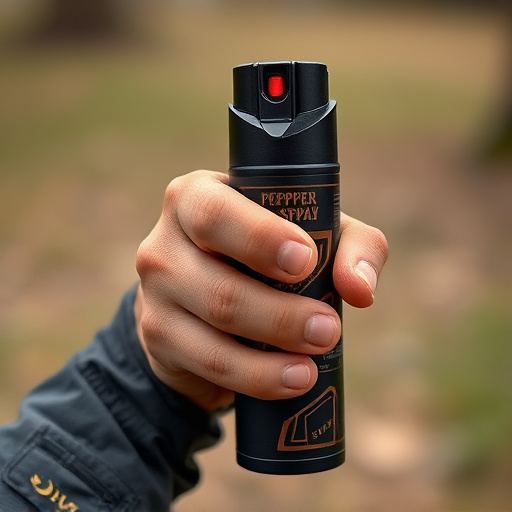Pepper spray, a capsaicin-based self-defense tool, temporarily disables individuals by irritating their eyes, nose, and respiratory system for 20-60 minutes, depending on concentration, weather, and target area. While it causes no permanent harm, proper understanding of its duration and application is essential for both effectiveness in self-defense and ensuring bystander safety. Key factors influencing effect length include capsaicin level, application method, environmental conditions, age, health, and tolerance levels.
“Uncovering the power behind police-grade inflammatory pepper spray: a comprehensive guide. This article delves into the intricate world of pepper spray composition, focusing on its active ingredients and their impact. We explore the science behind the duration of its effects, revealing what factors influence its longevity.
From understanding dispersal patterns to implementing safety measures, readers will gain insights into maximizing effectiveness while minimizing risks. Discover answers to burning questions, including ‘How Long Pepper Spray Effects Last,’ as we navigate through key considerations for effective and safe deployment.”
- Understanding Pepper Spray Composition and Its Active Ingredients
- The Duration of Pepper Spray Effects: What Science Tells Us
- Factors Influencing Pepper Spray's Lasting Impact
- Safety Measures and Dispersal Patterns: Maximizing Effectiveness and Minimizing Risks
Understanding Pepper Spray Composition and Its Active Ingredients
Pepper spray, a common law enforcement tool, is composed of various chemicals designed to cause temporary disability and disorientation. The primary active ingredient is capsaicin, a compound derived from chili peppers. This chemical irritates the eyes, nose, and respiratory system, leading to symptoms like tearing, coughing, and difficulty breathing. Understanding the composition and active ingredients is crucial in comprehending how long pepper spray effects last—typically ranging from 20 minutes to an hour, depending on factors such as concentration, weather conditions, and individual sensitivity.
The duration of pepper spray’s effects varies widely due to its non-lethal nature. While it can impair an individual’s ability to fight or flee in the short term, it does not cause permanent harm. The primary goal of law enforcement when deploying pepper spray is to temporarily subdue a subject, allowing officers to gain control and de-escalate a situation without resorting to more forceful measures.
The Duration of Pepper Spray Effects: What Science Tells Us
The effects of pepper spray are designed to be temporary, but understanding how long they last is crucial for both law enforcement and individuals seeking self-defense options. Scientific studies have provided insights into the duration of these effects, offering a clearer picture of what to expect. Typically, the active ingredient in pepper spray, capsaicin, causes a burning sensation and respiratory distress by disrupting nerve signals. According to research, the intensity of these symptoms peaks within seconds of exposure and gradually subsides over several minutes. On average, the effects of pepper spray can last for 2-5 minutes, though this duration may vary based on factors such as the concentration of capsaicin, the method of application, and individual tolerance or sensitivity.
While the initial impact might wear off after a few minutes, some individuals may experience residual symptoms like coughing, tearing eyes, and difficulty breathing for an extended period. This prolonged discomfort underscores the importance of using pepper spray responsibly and ensuring that bystanders are kept safe during its deployment. Understanding How Long Pepper Spray Effects Last is essential for both effective law enforcement tactics and responsible civilian use.
Factors Influencing Pepper Spray's Lasting Impact
The duration and intensity of pepper spray’s effects can vary significantly based on several factors, including the concentration of capsaicin, the method of application, and environmental conditions. Higher concentrations of capsaicin, the active ingredient in pepper spray, generally result in longer-lasting effects due to its increased ability to bind to nerve receptors. Direct contact with eyes, face, or open wounds can amplify the impact, leading to prolonged discomfort and potential temporary blindness. Weather plays a role too; high humidity might reduce the spray’s effectiveness as it evaporates slower, while dry conditions can make it linger longer, exacerbating its irritant properties. Additionally, individual factors such as age, health, and tolerance levels influence how each person responds to the spray, with younger individuals and those in good physical condition potentially experiencing symptoms for a more extended period.
Safety Measures and Dispersal Patterns: Maximizing Effectiveness and Minimizing Risks
Pepper spray, a powerful tool for law enforcement, is designed to incapacitate individuals temporarily, allowing officers to gain control and de-escalate situations. However, its effectiveness and safety are closely tied to proper application and understanding of its dispersal patterns. When deployed correctly, pepper spray can create a barrier, reducing the risk of physical contact between officers and suspects. This is crucial for minimizing both officer and public safety, especially in high-stress, dynamic scenarios.
The duration of pepper spray’s effects varies based on factors like concentration, weather conditions, and target area. On average, how long pepper spray effects last can range from 20 to 60 minutes. Understanding these dispersal patterns is essential for officers to make strategic decisions during operations. By knowing the reach and lingering effect, officers can ensure they maintain a safe distance while still achieving their tactical objectives, thereby balancing effectiveness with risk management in crowd control situations.
Pepper spray, a powerful law enforcement tool, is composed of specific compounds that deliver a swift and effective incapacitation. Understanding the duration of its effects, influenced by various factors, is crucial for both public safety and strategic deployment. By recognizing the science behind pepper spray’s composition, duration, and dispersal, we can ensure its responsible use while maximizing its effectiveness in real-world scenarios, making it an indispensable asset for law enforcement agencies worldwide.
